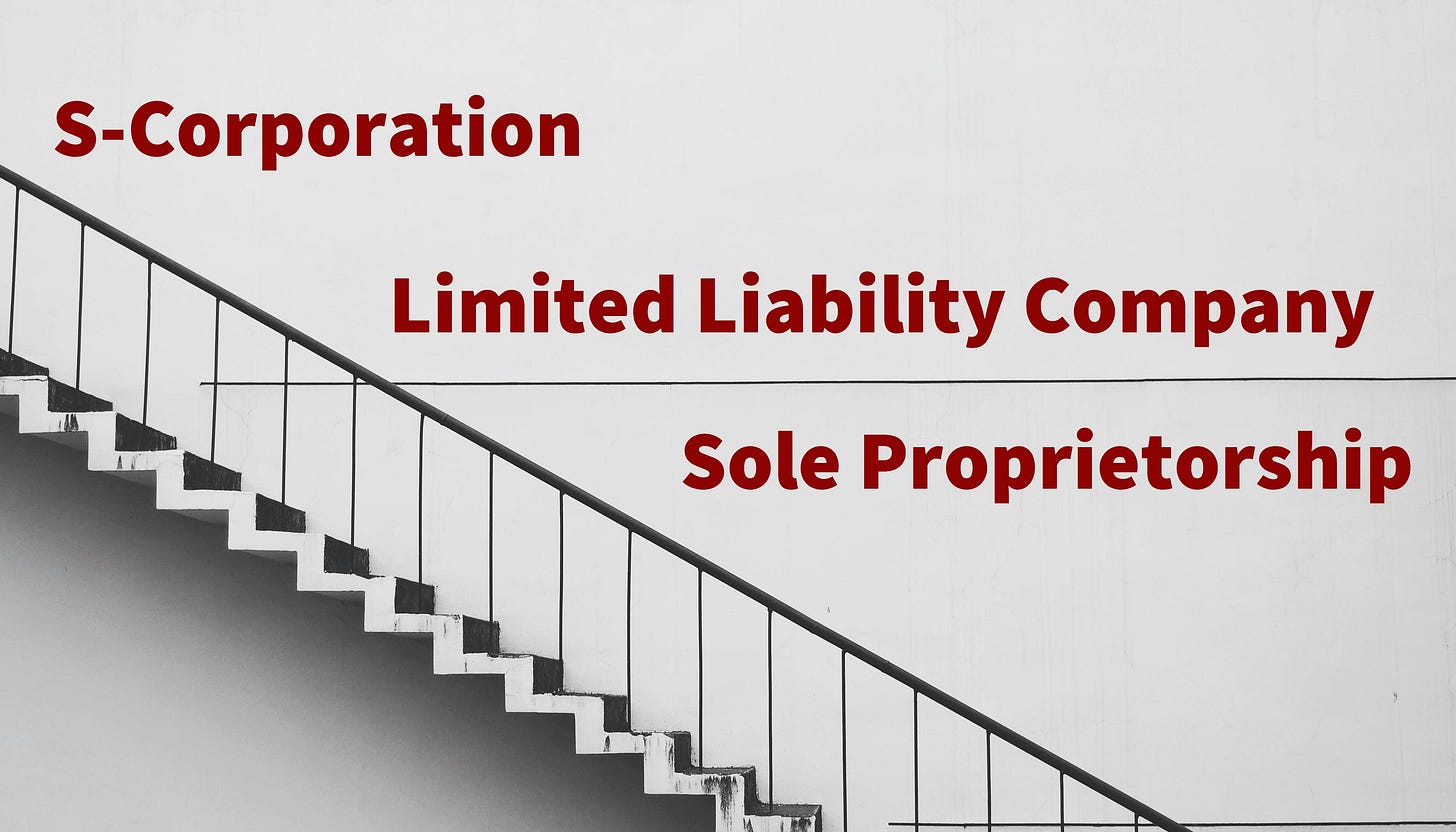12-Steps to Make Your Portfolio Business a Real Business (LLC or S-Corp)
Post #45: Don't just report your income on your 1040 (USA).
Bootstrap Your Business is a Substack community dedicated to supporting new and aspiring business owners with the process of starting, setting up, and operating a small business.
Join me on this Journey with DIY instructional content, commonly used templates and reusable files, and coaching advice! It’s all here!
Go to my Substack Home Page for additional resources for entrepreneurs and solopreneurs: 👇
Did you know…?
40% to 50% of small businesses in the U.S. operate as unregistered sole proprietorships.
These businesses typically mix personal and business finances, often missing out on tax benefits and legal protections.
In this newsletter, I’ll walk through the most important steps that you need to follow to make your Portfolio Business a Real Business.
If you're building a portfolio business that includes Substack, YouTube videos, digital products, and other revenue streams, registering a business can provide financial and legal benefits.
By making your business official, you can reduce your tax burden, establish credibility with clients, and set yourself up for long-term success.
This quick 12-step guide walks you through the basics of registering your business.

👉 Also, be sure to check out these resources:
Bootstrap Your Business Workflow - a step-by-step guide with the links to all of the top daily posts that walk you through the process from scratch
BYB Book Recommendations - a collection of the best business books to help you on your entrepreneurial journey
BYB Alerts & News - urgent updates for self-employed and business owners - delivered to your inbox - so that you can be more prepared
BYB Documents - a repository of guidance for important business documents with instructions and guides to use them in your self-employment journey
The Benefits of Having a “Real” Business
Many independent creators and entrepreneurs operate without a formal business structure, often mixing personal and business finances.
While this may work in the short term, registering a business provides several advantages:
Tax Benefits. Deducting expenses like software, marketing, and equipment is easier (and less likely to lead to an IRS audit).
Credibility. Your business will attract bigger clients who prefer working with registered businesses.
Legal Protection. Protect your personal assets from business liability.
Financial Organization. Keep your business finances clean by separating personal and business finances.
Quick 12-Step Guide
In this 12-step guide, I’ll provide a high-level rundown of what you need to do to turn your portfolio business into a Real Business.
Step 1: Choose a Business Structure
The best structure for your portfolio business depends on your goals and expected revenue.
Here are the common options:
Sole Proprietorship. Easiest to set up but offers no liability protection and harder to deduct business-related expenses.
Limited Liability Company (LLC). Separates personal and business assets, and easy to maintain. Simplifies deducting business-related expenses and selling your company when the time is right.
S-Corporation (S-Corp). Tax-efficient for higher earners but requires more paperwork. The best option for liability protection, privacy, and growth.
For most creators, an LLC is the best option due to its flexibility and liability protection. When you achieve a certain level of recurring revenues, upgrading to an S-Corp will yield enormous benefits.
Step 2: Write a Business Plan
A solid business plan is your roadmap to success. It helps you clarify your vision, plan finances, and stay on track as you grow. Even a simple one-page plan is better than nothing!
Define your mission – What problem are you solving, and who are your customers?
Outline your revenue model – How will your business make money? List pricing, costs, and profit margins.
Set short- and long-term goals – Identify key milestones for growth and success.
Plan for expenses – Estimate startup costs, monthly overhead, and financial needs.
Keep it flexible – Your plan will evolve, so update it as your business grows.
Step 3: Register Your Business Name and Entity
Once you have chosen a business name, make it legal to protect the business from competition and to secure the name as unique.
Before filing paperwork, keep these tips in mind:
If you’re using your legal name (e.g., "Jane Doe Consulting"), you may not need to register.
If using a brand name (e.g., "Smart Creator Media"), you can file a Doing Business As (DBA) or register the name when forming an LLC.
If forming an LLC or S-Corp, file the necessary paperwork with your state’s Secretary of State office. This typically involves:
Choosing a registered agent.
Filing Articles of Organization (LLC) or Incorporation (S-Corp).
Paying a registration fee ($50–$500 depending on the state).
Step 4: Apply for an Employer Identification Number (EIN)
An EIN is like a Social Security Number for your business.
You’ll need it to open a business bank account and file taxes. Get one for free from the IRS website.
Step 5: Upgrade to an S-Corp (If Needed)
If your portfolio business is making significant income (generally over $75,000 in net profit), you may want to elect S-Corp status to save on self-employment taxes. Here’s how:
File Form 2553 with the IRS to elect S-Corp taxation for your LLC.
Set up payroll for yourself to pay a reasonable salary, avoiding excessive self-employment taxes.
Consult a tax professional to ensure compliance and maximize tax benefits.
Step 6: Set Up a Business Bank Account
Once your business is registered and you have an EIN, open a business bank account to separate personal and business finances.
This helps with taxes and keeps your records clean.
Step 7: Understand Your Tax Obligations
The only two things that you can rely on are death and taxes. Be sure to pay your taxes or you could get into serious trouble
Self-Employment Taxes – As a business owner, you’re responsible for your own taxes.
Quarterly Tax Payments – If you expect to owe more than $1,000 in taxes, make estimated quarterly tax payments to the IRS.
Deductions – Track expenses like software, subscriptions, and home office costs to lower your taxable income.
Step 8: Keep Good Records
Use accounting software like QuickBooks, Wave, or a simple spreadsheet to track income and expenses.
Keep receipts and invoices organized for tax time.
Track income and expenses to ensure accurate financial reporting and easier tax preparation.
Record home office expenses if you work from home, as they may be deductible.
Stay organized for quarterly tax payments by maintaining clear financial records to avoid surprises when taxes are due.
Step 9: Get Organized
To maintain a well-structured business, implement an organization system for your records:
Retain or scan paper receipts into digital storage for easy access.
Organize digital files into a logical document repository to streamline access.
Keep a physical storage system for important paper documents like signed contracts and legal agreements.
Understand record retention rules – Some records need to be retained longer than others (link to article on this topic).
Step 10: Consider Business Insurance
Whether you're a consultant, digital product seller, or content creator, having insurance can protect your business. Some clients may require it before working with you. Consider these coverage types:
Professional Liability Insurance – Protects against claims of negligence, errors, or omissions in your work.
General Liability Insurance – Covers third-party bodily injury, property damage, and advertising liability.
Content Creator Insurance – Specific coverage for copyright claims, defamation lawsuits, or intellectual property issues.
Step 11: Renew Business Registrations and Stay Compliant
Many business registrations, licenses, and tax filings must be renewed periodically to remain in good standing. Be sure to:
Renew your LLC or S-Corp registration annually or as required by your state.
File annual reports and pay any necessary fees to avoid penalties.
Keep business licenses and permits up to date based on your activities.
Monitor tax deadlines to ensure timely payments and filings.
Step 12: Don't Forget to Pay Yourself
Your business should pay you like any other employee. Set up a system that ensures consistency, tax compliance, and long-term financial security.
Use a payroll service to handle tax withholdings like Social Security, Medicare, and federal/state taxes.
Contribute to a 401(k) or other retirement plan to build long-term savings with tax advantages.
Set up benefits for yourself, including health insurance, disability coverage, or even an HSA.
💡 Tip: New article on this topic is coming soon! Subscribe to get notified when updates are published!
Registering your business may seem like a complicated process, but it’s the best way to turn your portfolio career into a sustainable and profitable venture.
By following these steps, you’ll gain tax advantages, build credibility, and prepare for future growth.
No matter your revenue streams—be it Substack, YouTube, or digital sales—structuring your business properly sets you up for success.
If you found this guide helpful, share it with fellow entrepreneurs!
Have questions about business registration? Drop them in the comments.



















